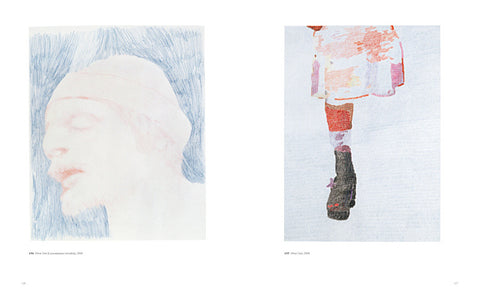In the 1980s, when Monika Sprüth and Rosemarie Trockel were asked why their sporadically published magazine “Eau de Cologne” featured no male artists, they replied with a brazen “oops, no men, we hadn’t noticed.” Their playful simulation of the disregard endemic in the male-dominated academic system remains integral to Trockel’s work after 3 decades, and she continues to subvert established structures with a similar feminist voice to Jenny Holzer, Barbara Kruger and Cindy Sherman. Naturally, this inherent chauvinism was more prevalent during Trockel’s inauguration into orthodox art networks. However, due to its necessarily indeterminable nature, and despite its gradual dissipation, it remains at the fundamental roots of our cultural coding. Thus, the idea of complete elimination has been replaced by attempts to undermine the parasitic nature of this built-in sexual hierarchy.
Trockel’s ‘knitted paintings’ were her ticket to fame, their novelty value perfectly appealing to the zeitgeist of the late 1980s; marking a devaluation of inherently feminine art procedures, alongside an exemplary Baudrillardian notion of the arbitrary sign/signifier relationship. Despite the critical, and popular, success of Trockel’s ‘knitted paintings,’ her drawings remain integral to her work, and Edinburgh’s Talbot Rice gallery, in conjunction with Kunstmuseum Basel and Kunstmuseum Bonn, presents more than 200 of her works on paper. The exhibited pieces are steeped in art history, with direct references to Warhol, George Grosz, Rubens and Käthe Kollwitz, alongside indirect, aesthetic allusions to Dumas, Hockney and David Shrigley. Remember Uncle August, the Unhappy Invention (1993) creates a clear parallel with Grosz’s 1919 collage Remember Uncle August, the Unhappy Inventor, directing attention to the notion of ‘male artist’ as an invention, rather than inventor, of academia.
Untitled (2000) shows a skirt of warm, mottled hues resting on a single, perfectly poised, disembodied leg. Coloured pencilling, reminiscent of Hockney’s portraits of the 1970s, constructs the form of the asymmetrical subject, her childish boot imparting the vague impression of a young girl, meandering, playing a game against herself. Although painstakingly rendered, this repetitive mark making is not something instrumental in Trockel’s art practice. Her frequent employment of acrylic paint with the translucent appearance of watercolour demonstrates a resolution to obliterate the blatant formations that determine representation. Thus, Trockel’s manipulation of drawing is not only conceived as imprinted fleeting thought, but also, as in the work of Daniel Buren, as a paradigm of her uncertainty concerning the nature of re-presentation administered, and dictated by authoritative systems.
Vorstudies show oblivious male figures, with delicate explosions of white on their backs, portraying something between the stains of ejaculation and bird shit, to which these male victims are entirely oblivious. The ignorance of the figures is immediately intelligible, as are the stains themselves which, together, provide a voyeurism entirely indebted to Trockel’s own engagement with a predominantly male environment. Although Trockel’s work affords a feminine sensibility, as well as aligning itself with necessarily feminist concerns, her work is not reduced to feminist art. Her drawings and collages achieve a delicate, clumsily visceral texture, with a simultaneous crude brutality, that speaks more of a constant interaction with the inaccessible and contradictory nature of humanity, rather than constantly drawing our attention to the male/female divide. Trockel does not employ the categorical imagery or references found in characteristically feminist works, such as Judy Chicago’s infamous The Dinner Party, but instead manipulates us towards a gradual realisation of the limitations that result from a male-orientated academic culture.
Trockel creates a world where men resemble monkeys, and their noses resemble penises, where subjects are often obscured by black hats or masks, or severed at the neck. Her visual language permeates her entire oeuvre, despite its schizophrenic nature, and manifests most significantly in her paper works. Drawing allows Trockel “both springboard and experimental space [that] for all its heterogeneity evinces continuities of both form and space.” Even her drawing, then, continuously oscillates between subject and aesthetic, but sustains her idiosyncratic discourse. If drawing functions as pure experimentation, then her more recent use of collage allows her experimentations to be reformed and re-contextualised. Schlafmohn (Opium Poppy) (2001) features Trockel’s reoccurring motif of the black hat, obscuring the head of the subject, whilst his body rests somewhere between lounging and crouching. Trockel’s preoccupation with sexual delineations results in this appearance of animal-like states, juxtaposing the unconscious mind and the primitive nature of beasts.
Trockel’s “book-drafts” – never exhibited so extensively before – unveil the artist’s undeniable prolificacy; they function like relentless proposals, blue-prints, fleeting thoughts, philosophical musings, microscopic observations of human life. Her notebooks are a similar validation of her consistent engagement with social implications, and her dissension of male-dominated cultural production. Theatrical, chimerical, grotesque and threatening, Rosemarie Trockel’s subversion of artistic frameworks necessitates an unsettling array of works. Through eschewing her multi-faceted work in sculpture, painting and film, Talbot Rice has astutely presented the most engaging works in her oeuvre. Trockel’s attempts to disrupt curatorial roles, and museological dictations, are subtle enough to be almost imperceptible; the processes she utilises are so firmly integrated into the codes she wishes to subvert, that any political implications her work may have, cannot escape the inevitable danger of going unnoticed. Realisation does not necessarily come in the gallery space, but Trockel’s meticulousness ensures that it will come at some point, bringing the limitations of a chauvinist culture crashing down with it.

No comments:
Post a Comment